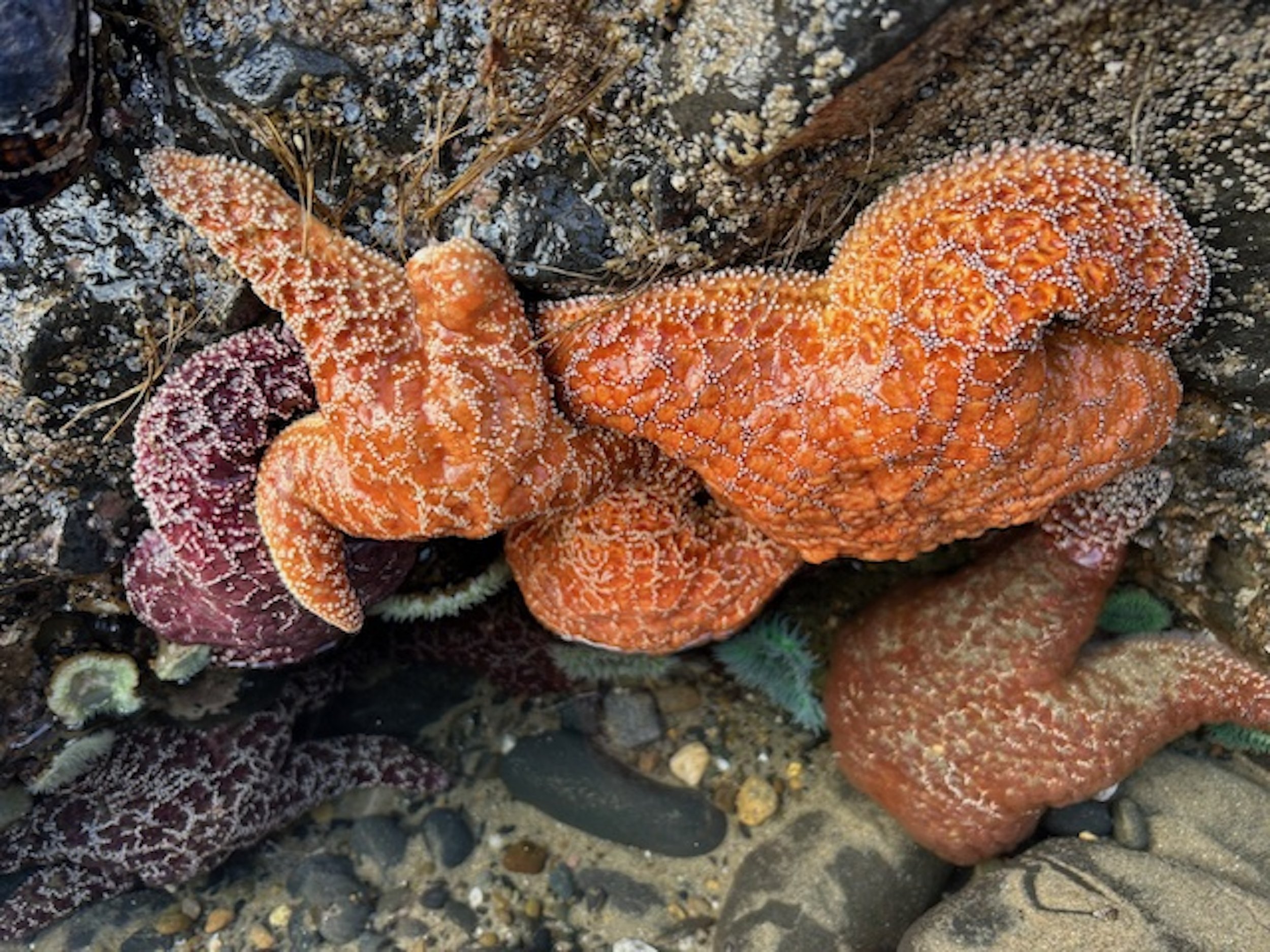Alien world
Exploring Seal Rock’s mysterious creatures at minus tide


By Michael Edwards
For the TODAY
A hermit crab forages for scraps in a salt water pool. The sight of a crow’s beak probing the seaweed for invertebrates sends the startled crab tumbling into a bed of broken mussel shells. A sculpin darts across the pool. The well-camouflaged fish vanishes into a cave guarded by giant green sea anemones. Above the water line, brilliant purple and orange ochre stars clump together to conserve moisture. Standing nearby, a western gull methodically squeezes the water from an unlucky ochre’s hydrostatic skeleton. Another gull circles overhead and lands. “Is pilfering this star worthwhile? It looks stuck in Jerry’s throat.” After watching the ochre-eating gull’s pained look, the hungry gull walks over to a declawed red rock crab lying on the beach. In the lagoon, harbor seals soak up whatever meager warmth the February sun provides. On the high rocks, an oystercatcher’s ear-piercing pips lets a rival know that the limpets are hers.
From Baja California’s desert coastline, to the rainy fjords of Southeast Alaska, the Pacific Coast’s rocky intertidal zones teem with life. Millions of years of evolution has granted intertidal species time to adapt to the punishing environment. Twice-daily tides deliver food and remove waste. Intertidal creatures face exposure to the elements and pummeling surf. Seal Rock’s tide pools offer visitors a mysterious and accessible alien world to explore.
Keen observers will notice chitons suctioned to rocks. Like many of the intertidal creatures, the chiton isn’t going anywhere, at least until the tide comes in. Look for the black leather chiton’s diamond shaped plates and black girdle. Once you see one, your eyes will adjust, and more will appear.
The chiton is a living fossil. For hundreds of millions of years these humble mollusks have employed their radulas to scrape algae from the rocks. Over eons, the magnetite coating the chiton’s teeth have worn grooves into the rocks. UC Santa Barbara researchers discovered that chitons have tiny prehistoric eyes on their shells. When asked what the chitons can see, marine biologist Rebecca Varney at UC Santa Barbara said: “Chitons don’t really have a reason to cooperate with you, so figuring out how to ask a chiton what it’s looking at is a hard task.” Maybe that child of yours whose pants pockets dump sea shells and rocks into the dryer will be part of the team who figures out the mystery of the chiton’ vision.
At low tide, a purple ochre sea star clings to the rocks with its thousands of powerful tubed feet. When the tide rises, the star creeps up on a California mussel, envelopes it and pulls it apart. The mussel’s soft tissue is liquified and eaten by the star. The ochre sea star is an apex predator. When sea stars vanish, mussels take over and crowd out the other creatures.
Undulating slowly between swaying kelp fronds, a translucent Dirona Albolineata hunts anemones. Unlike other intertidal creatures, the ghostlike nudibranch eats anemones without igniting their stinging nematocysts. The hungry nudibranch devours an anemone and stores the unfired nematocysts in its dorsal appendages. The rookie predator who swims by and tears off one of the nudibranchs now lethal appendages gets a mouth full of exploding stingers.
Exploring Oregon’s tide pools is a pleasant pastime. It’s also free, which is especially nice at the end of the month when the bank account balance sits at $2.37. Spend a couple of phone-free hours with the kids bathing in nature’s alien world.
Visit during low tide. Minus tides are best. The Tide Alert app, NOAA’s online tide charts, or the tide tables on page 19, will provide you with the information you need. Wear durable shoes: flip flops are good for swinging wildly at raccoons with but, when worn on rocky slick surfaces, they are a trip hazard. Be careful where you step. When possible, walk on bare rock. The red algae is slick and barnacles prefer not to be crushed. Take only photographs. Intertidal creatures have evolved to live right where they are. The bright orange and purple ochre stars and giant green sea anemones will not survive in your bathtub, and when they die, they stink. Finally, even at low tide, respect the ocean’s power and unpredictability.
